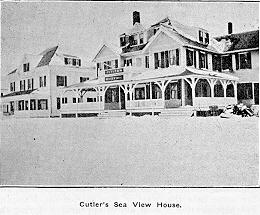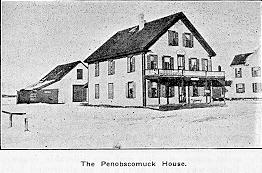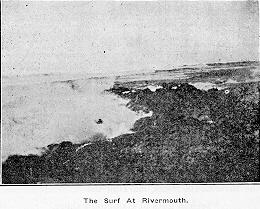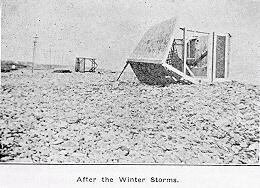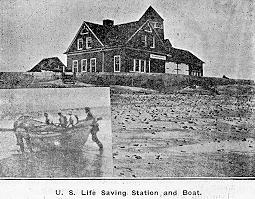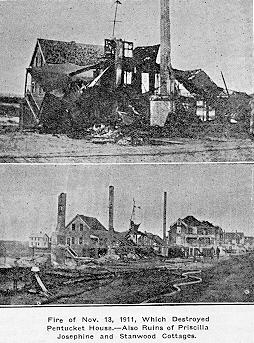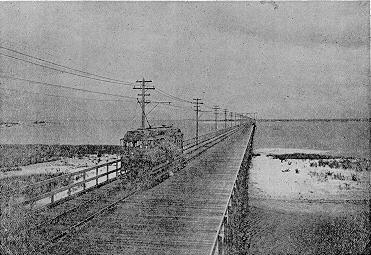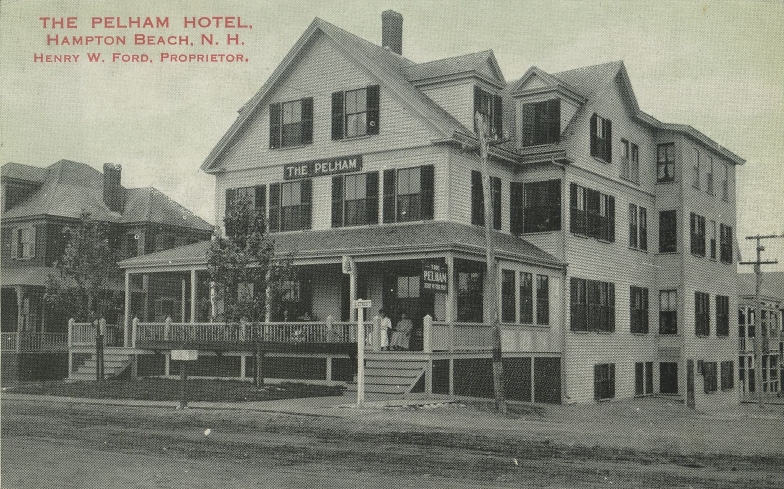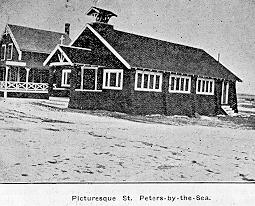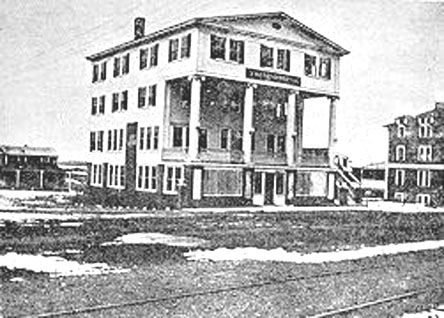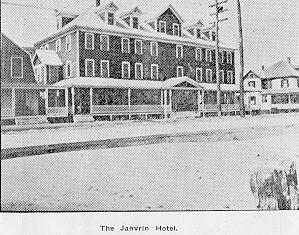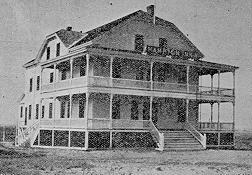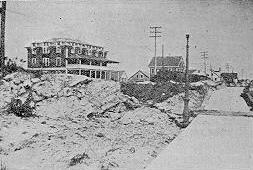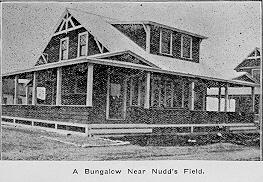By Harry Alden Johnson
Copyright 1913, Haverhill, Mass.
WINNICUMMET — The Past:
“Waves in the sun, the white-winged gleam
Of sea birds in the slanting beam,
And far-off sails which flit before the wouth-wind free.”
Down beside the ocean, and occupying five miles of New Hampshire’s scant fourteen of seacoast, where low green meadows touched now and then by the ebb and flow of the tide, and long lines of white, glistening sand dunes meet the eye of the summer sojourner, lies Hampton beach, a resort which from a very early time has achieved prominence, and which as the years go on, is making rapid strides as a popular vacation—time abiding place.
Not far from Hampton Falls, where Whittier, the poet of New England, the friend of the slave and the Abolitionist passed his declining days; on the ocean boulevard, one of the three state highways of New Hampshire, and within easy radius of Portsmouth, the quaint old seaport city, the place is one that is accessible from all points, which may to some extent account for the vast business which is steadily upon the increase.
Soon after the settlement of Hampton by the Rev. Stephen Bachelor in 1638, the first road along the ocean front was laid out from Great Boar’s Head to Portsmouth. Bachelor, to whom the town owes its settlement, came from England, being more than seventy years of age when he arrived in America where he set out to try his fortunes. A little band of sturdy pioneers of his faith came with him, but before settling down in Winnicummet or “The Place of the Beautiful Pines” which the Indian name typifies, Bachelor and his followers made short stays in Boston, Lynn, Ipswich and Newbury, none of which appealed to them as did Hampton, where they were given permission to settle by the General Court of Massachusetts.
This pioneer band selected Hampton as an old record states, “on account of the great store of salt marsh which did intice the people to set down their habitation there, having about 450 heads of cattle.” The name Winnicummet still survives in the calling of the main highway along the beach northerly toward Portsmouth from Great Boar’s Head [Ed.: Today, Winnacunnet Road extends from Ocean Boulevard (Route 1A) by the ocean, to Lafayette Road, (Route 1)].
Hampton and Hampton Beach are also rich in their poetic heritage, and many spots have been made immortal by the lines of Whittier who spent many summers at the Gove homestead at Hampton Falls where his death occurred in 1892. From his boyhood days, he had frequently visited the seashore, driving down with the family to spend a day
And ripples the cool breeze.
A tent was usually pitched for the day, the members of the party passing the time merrily with the various recreations which the occasions offered. At noon a hot lunch would be served, and to the children the day was a gala one indeed. Many of the events and traditions the poet has immortalized in his flowing verse, and to the tourist today all these spots have the most hallowed associations.
Pitched their white tents where sea-winds blew.”
Early Hostelries:
The first dwelling house erected at the beach was in this same locality, and was put up shortly before 1800. It was a rude log structure built by one John Elkins who was born during the Revolutionary War era. Later he sold the property to Moses Leavitt who kept a sort of tavern during the summer months when travel along the ocean highway was more frequent. Leavitt’s wife was Molly Brown, famous as one of the best of cooks which was perhaps the reason that the Leavitt house was so well patronized. From that time, descendants of the Leavitts have been engaged in the hotel business, the present Leavitt hostelrybeing located at the bend in the road near Boar’s Head, which for many years was the thickly settled section of the beach.
“For several decades, the first Leavitt house was patronized by the fishermen who annually came down over the road from Vermont to return with loads of frozen mackerel, cod, and other fish which the beach residents had caught and cured. The local fishermen disposed of their spoils of the sea to the wholesale merchants, who in turn sold their fish mainly in the Canadian markets. The industry was a large one, and for some time, the practice was carried on, Hampton beach presenting a most active appearance during the fall and winter months.
Another early house of entertainment was kept by Amos Leavitt and his two sons, Jacob and Moses and then followed the erection of a small house “For Travailers,” which was built in 1807 and kept by Daniel Lamprey. He was a farmer who owned and tilled considerable land in the vicinity of the beach. Lamprey also catered to what transient trade there was, and at times he made good profits.
The year 1819 noted the building of the first actual hotel, and this was situated at Boar’s Head. It was a large building for that time, commanding an unbroken view of the sea, the Isles of Shoals, and Agamenticus, with nearer at hand the Hampton meadows and marshes, and Rivermouth rocks, with the pines of Rye towering on the western horizon.
Abraham Marston was its proprietor, and for a long period, the hostelry was a familiar landmark for miles around. The building was finally destroyed by fire.
About 1822, Richard Greenleaf kept a tavern on the same site as the old Lamprey house, the building later being enlarged by Thomas Leavitt, who did business there until the place was burned to the ground.
The old Granite house stood near the junction of the Hampton and Portsmouth roads, and was afterward known as the Rockingham house. A quarter of a century or more ago it was acquired by Col. Stebbins H. Dumas who carried on the hostelry for some time under the name of the Dumas house.
The Nudd family has long figured prominently in the hotel life at Hampton Beach, as far back as 1830, when David Nudd built the Eagle House, the place having been used continuously as a hotel. It was later enlarged, and is still standing and owned by the descendants of the original building. Stacy Nudd for some time, kept another hotel further to the south, near the present home of Ashton Lee, and finally this was renamed the Ocean House. The building was destroyed by fire in the conflagration of 1885 when 17 houses and the large skating rink were burned to the ground. Among these was Col. John G. Cutler’s hotel, upon the site of which stands the present Sea View House, a hostelry that is known far and wide. The house was built in the short space of twenty—six days, and forty-two men were employed in the work, so that the building was completed and ready for occupancy in time for the opening of the summer vacation business. This hotel has been the scene of innumerable political gatherings, dignitaries of both State and the National government have been entertained beneath its hospitable roof, and guests from far and near have sat upon its piazzas or discoursed with its venerable proprietor. The interior walls of the house contain some notable paintings which were executed by the late Andrew Jackson Price of Exeter. The scenes portray bits of landscape and marine views and have achieved for the artist many plaudits and considerable renown. Col. Cutler was widely known as an all—around hotel man, and for decades he was a familiar figure in the civic life of the town and beach where he made his home throughout the year. His death occurred in February, 1913.
The land grants made to both Georges and Mason included Hampton and the territory adjoining, and from a very early period there have been numerous mentions made of the town and its long expanse of sandy shore where
Breaks on the rocks, which stern and gray
Shoulder the broken tide away,
Or murmurs hoarse and strong through mossy cliff and cave.”
The Wreck of Rivermouth
“Once in the old Colonial days
A boat sailed down through the winding ways
Of Hampton river.”
On an autumn day in the far—off year 1657, a boat threaded its way among the low green marshlands, sailing from the village of Hampton
down to the little harbor, guarded on either hand by the Rivermouth rocks, marking the
It was filled with a happy company bound for a day’s fishing off the ledges, and all hearts were light and merry as the cloudlets in the sunny expanse o’er their heads. Little did its members realize that
Would sail again into Hampton river.”
Nor did the luckless maiden who laughed merrily at the old witch seated in the doorway of her miserable hut, dream that ‘ere many hours the happy excursionists would be cold in death on the selfsame rocks shining so bright in the mellow sunshine. Whittier has told the tale in his “Wreck of Rivermouth,” how Goody Cole made her imprecations as she watched the craft as it rounded the point where she
A bent and bleary-eyed poor old soul,”
how a sudden and violent storm came up in a trice, the wrath of the gale descending upon the fishers.”
Their bodies, eight in all, were recovered a few days later, and their funerals were held
Where side by side the coffins lay.”
An old record in chronicling the affair says “The sad hand of God fell upon eight persons going in a vessell by sea from Hampton to Boston who were swallowed up in the ocean soon after they were out of the Harbour.”
Destructive Storms
We saw the white spray tossed and spurned.”
Hampton has been the scene of several wrecks, conflagrations, and severe storms, the most disastrous of which was the cyclone of July 4, 1894. Houses were demolished and blown into the sea, over twenty in all being destroyed. The large skating rink which stood at the upper end of the beach was blown down, and a yacht owned by Capt. Frank Nudd, with a party of nine, was badly battered by the raging storm, five being lost at sea, during the gale. The loss was estimated at several thousands of dollars, and it was some time before all traces of the debris had been cleared away.
In February, 1723, there was a storm of unusual severity of which Cotton Mather, the early New England historian wrote “The sea at Hampton was twenty inches higher than ever known before, and broke over the banks for miles, and continued running high for many hours.”
At another time there was a terrific hail storm so severe that the sand was covered with hail stones to a depth of more than a foot. The famous “Dark Day” of New England, May 19, 1780, was also especially noticed at the beach, and many of the settlers in the village adjourned to the meeting house where they spent the entire day in fasting and prayer.
The few dwellers at the seashore hurriedly made their way to town, taking with them their choicest possessions, and many were fearful that the Day of Judgment was at hand.
Coast Disasters
“Alas the gallant ships that sailed
On blind Adventure’s errand sent.”
One of the most notable wrecks described in history was that of the St. George, one of his Majesty’s mast ships which came ashore on the Hampton ledges. This was on Nov. 30, 1764, the craft, which was one of the largest in the service, being bound from Boston to Portsmouth, where a cargo of masts from the forests of New Hampshire, and marked with the King’s arrow, awaited shipment. The entire crew of seven was lost, the wreckage strewing the waterfront the entire length of the beach. Tradition states that the first rat was brought to this country by this same ship, and Belknap, the historian, refers to the fact in his chroniclings. The “Sir Francis,” also a British steamer with its cargo of tin—plate, iron and steel, was wrecked off the Hampton shore in February, 1873.
The wreck of the Glendon, a coal—carrying schooner occurred during the latter part of February, 1896. The craft was originally a steamship, and was converted into a three—master. She had a crew of seven men, and was driven ashore in a furious gale from the north east. The crew was saved, the life—savers from Wallis’ Sands and the Straws Points stations rendering valuable assistance. This wreck was largely responsible for the building of a government station at Hampton Beach which was completed a year or two later. A cottage built about that time bears the name of the Glendon, and commemorates the wreck.
In a fierce storm on December 18, 1900, the small fishing schooner “Mary Brown” was driven into the harbor enclosed by Great Boar’s Head on the north, and was badly battered, and for many hours at the mercy of the gales and heavy sea. She was a total loss, the captain and five men losing their lives. The remains of the craft are now beached opposite the Casino, a tablet telling the tale of the tragedy of the sea.
Natural Scenery
“But beauty seen is never lost,
God’s colors all are fast.”
A guardian of the sun—lit bay, whose broad flats at ebb tide furnish employment for scores of picturesque clammers, the rocks of Rivermouth are among the most attractive of Hampton’s many assets. The angry surf dashes upon their rugged pinnacles here and there uncovered, great white—winged gulls dance and wheel over the silvered waters, and the long, sandy expanse of beach shines and glimmers in the sun. In the late summer days, great piles of salt hay, cured by the neighboring farmers, dot the marshes here and there, and at times once catches a glimpse of
And beyond, the steeples of the town.”
Here innumerable creeks and inlets touched now and then by the oft—receding feet of the tide, are visited by the boats of the fishers, or in the autumn perchance ring with the hunter’s gun, as the noisy sea—fowl are found in abundance. At evening, across the plain of marsh—land, the vacationist at Hampton may behold sunsets that are unrivalled for their beauty and wealth of color. Great crimson clouds fleck the whole western sky, illumined here and there by the golden rays of the departing sun which peer through and transfigure the entire horizon.
Sometimes, too,
“In calms of closing day” one sees
“The spectral mirage play,” a group of magical islands appearing seaward to the right of the Isles of Shoals, with a wondrously clear outline of a land fringed with stately palms, a vast settlement of houses with often a tall and stately minaret, and nearer at hand, the mysterious vision of a ship, clearly discernible, and apparently not far away. Gradually the vision fades, first growing less distinct, then a mist seems to envelop the entire scene, and a moment later the enchanted islands disappear from view as though a curtain had been let down from the azure blue sky, and falling into the sun—lit sea, had left the fairy islands in a world of their own, beyond the ken of mortal man.
Accomplishments of Two Pioneers
“No task is ill where hand and brain
And skill and strength have equal gain.”
In the olden days several vessels were built at Hampton, but the industry died out after the Revolution. Capt. Nathaniel Healey was the master spirit of this enterprise, and he also was the prime mover in the excavation of a canal which connected the Hampton and Merrimack rivers. The work was a most laborious one, but was finally completed in 1791, small vessels being enabled to go from one river to the other without putting out to sea. This was an important feature in those days and the canal was used extensively by the fishermen who were in the habit of visiting Ipswich for their daily supplies of bait. Capt. Healey, who spent nearly his entire fortune in the undertaking, was born in Kensington in 1757. He was graduated from Harvard College, and died in 1823. The canal is still navigable, although it has never been used to any great extent.
Originally, most of the farmers in the neighborhood of Hampton owned some marshland or “mash” as even today it is called by the country folk of Seabrook, a quaint old town close by. In 1662, the owners of land near the ocean were given permission “to set up gates” in order to prevent the cattle from trampling upon the grass. At this period many horses and cattle fed at will along the marshes, their owners turning them loose in the fall to seek their own sustenance during the long, cold winter. A law put an end to this practice in 1671.
William Hopkins, who came from England in 1848, conceived the idea of draining the marshes, and he once set to work digging ditches which greatly improved both the quality and quantity of the grass which has always been used extensively for winter feed for cattle.
The Famous Mile-Long Bridge
“You hear the pier’s low undertone
Of waves that chafe and gnaw.”
No description of Hampton Beach could be complete without mention of the famous “mile-long bridge,” which spans Hampton river close to the point where it enters the sea, and is the connecting link on the ocean boulevard between the sister states of New Hampshire and Massachusetts. The structure is a remarkable feat of engineering, cleverly conceived by Wallace D. Lovell and built by his interests, with Ralph D. Hood of Haverhill, Mass., the designer. The bridge is now owned by the Massachusetts North Eastern company, and its trolley lines pass over it as they enter the state from the south east. During the summer season, it is maintained as a toll—bridge and is the only structure of its kind in New Hampshire. The bridge is also famous as the longest wooden bridge in the world, and it was formally opened on May 14, 1902, being built at a cost of approximately $100,000. Its erection makes an uninterrupted electric shore line from the Merrimack to the Piscataqua rivers, passing through three states. It lacks but two hundred feet of being a mile in length, and is built on wooden piles of which an enormous number was required.
The dedication of the long structure was marked by elaborate exercises which took place mid—way upon the bridge, after the first car had been run over it with former Governor Chester B. Jordan of New Hampshire at the controller, and with other dignitaries and officials upon the front platform. In the middle of the bridge a temporary platform had been raised, draped with the national colors, and while a brass band furnished music, appropriate dedicatory exercises took place. Gov. Jordan, who was one of the first speakers, commented upon the immensity and wonder of the bridge, and congratulated the architects and designers.
Others who gave short addresses were Hon. Henry M. Putney, chairman of the New Hampshire railroad commissioners; Hon. N. J. Batchelder, Master of the State Grange; Hon. John McLane of Milford, and Dr. Charles S. Murkland, president of the State College at Durham. The exercises were preceded by an elaborate dinner at Whittier’s Hotel for which more than two hundred covers were laid, the Governor and members of his staff being among the honorary guests, with many officials of Rockingham & Essex counties.
From this great wooden structure, the tourist secures a view of sea and shore that is truly magnificent. The rugged outlines at the mouth of the river, the occasional gleam of a white sail dotting the great blue expanse of the sea, the bold and rocky promontory of Boar’s Head, innumerable creeks and inlets bordered by the sea grass brown and sere, and
And the fish—hawk’s rise and fall,”
all make a scene that is accentuated now and then by
And the rush of the sea at flood,”
so that one who stands upon the great causeway beholds a panorama which can never be forgotten.
The harbor at Hampton during the summer months is fairly alive with small sailing craft, and one hears the almost constant “chug—chug” of the motor boats, swift little water—sprites which are fast replacing the dories and sail boats once so commonly made use of by the fishers who with sails all furled started out to sea when
Great white-winged gulls, the curlew, gray and serene, and scores of smaller sea—birds have their haunts here, and frequently the air is dense with their flapping wings, rising as a cloud of vapor from their feeding grounds, the flats and marshlands.
White Island is a popular section of Hampton’s summer colony, and within the last few years, scores of cottages have been erected here.
The old—time name of “Squatter’s Island” is now nearly forgotten, only one or two of the original huts recalling the days when Hampton was unknown as a summer play—ground and before its possibilities became known in more than twenty states whose residents are numbered among the colonists of the present day.
The Resort of Today
“By the summer sea
whose sands are traversed by a throng of voyagers.”
The summer homes are of more than ordinary beauty, and many are most artistically designed, with flower beds and walks lined with shells which contribute to the attractiveness of the place as a resort.
There are several large hotels as well, including the Ocean House, next beyond the large Casino, with its several thousand feet of veranda space, the Janvrin, The Ashworth, The Pelham, the Hill—Crest Inn, the Avon, and many others, all of which have full quotas of guests during the summer season.
St. Peter’s By—the-Sea, a pretty rustic chapel was dedicated with appropriate ceremonies on July 21, 1912, the rector, Rev. Charles W. Tyler, D.D., of St. John’s church, Haverhill, Mass., and the Bishop coadjutator of the New Hampshire diocese, participating. The building cost approximately $3500, and was the result of four years of activity upon the part of Rev. Dr. Tyler who had the distinction of erecting the first church edifice upon Hampton Beach. The altar was the gift of St. Mark’s society of Fall River, Mass., and the bell formerly hung in the old Wingate church in Haverhill.
Here, too, is Bethany Cottage, a summer home for the fresher movement which is maintained by the City Mission of Manchester, N.H., the work each season being in charge of Miss Mattie E. Strong, the city missionary. The house was first opened in 1906 and each year the work has been materially increased. The home of the mission was originally a part of the old Boar’s Head Hotel, and it commands a fine view for miles around. Many of its rooms are memorial rooms and not only individuals, but clubs and societies have assisted in the enterprise. Now and then one of the little waifs tiptoes in and deposits in some drawer or hiding place wonderful treasures gleaned from the sea close by. There are shells of wondrous beauty, the curious star—fish, great, round sand dollars, and even snail and clam shells, the results of happy hours spent in busy search along the sandy shore, which are to be treasured tenderly and taken back to the hot crowded city to show to father, and mother and younger sisters and brothers. And so each day passes much the same, and often at nightfall, all gather in the big living room and the song books are distributed before going to bed. “America” is about the only song each child is certain to know, and a passerby in the early evening hours when the shadows are descending upon the little settlement high on the frowning cliff might hear a score of childish voices in jubilant singing: —
Thy woods and templed hills,
Thy name I love.”
Then quiet pervades the rest of the cottage, as the tired, happy, children float away to Dreamland in their neat, white cots.
High on Boar’s Head, standing as a sentinel to the gateway of the sea is the water tower, a familiar landmark to the coasting steamers as well as to the residents of the neighboring towns of Hampton, North Hampton, Seabrook and Rye. Its height is ninety feet, and its width fifteen feet, the structure standing on a firm cement base. From this reservoir, water is distributed throughout the beach, and it also provides protection in case of fire. Volunteer fire companies have been formed, and much has been accomplished in guarding against such conflagrations as in times past have wrought irretrievable damage.
The beach is fine and hard, and at low tide walks along the shore and the sea—wall walk are pleasant forms of recreation. The Casino contains a spacious dance hall, a theatre, and dining room, the large building being the centre of social life when the season is on.
Daily band concerts on the ocean front are popular with the vacationists at this fine coast resort, while scores of summer people enjoy the sea bathing which is safe from all under-tow which makes Salisbury beach, the neighboring beach resort so dangerous for this pastime.
A long row of electric lights has recently been installed along the sea—wall, and at night when these are illuminated, the beach is a veritable line of red and white lights, making a display that is exceedingly picturesque.
Each year “Governor’s Day” is one of the gala events at the beach, the governor of New Hampshire and his staff coming annually to participate in the field day exercises of the New Hampshire State Grange, which are usually of an elaborate nature. A baseball oval in the rear of the Casino, attractions of the Midway, and like amusements are among the features of entertainment at Hampton which makes the resort a popular one with church and charitable societies, who, during the year enjoy many outings here.
The Sea Wall Walk
Winnicummet — The Future
“I know not what the future hath
Of marvel or surprise.”
As in a few years such progress and achievement has been realized at Hampton Beach, and a resort that was previously comparatively unknown has forged to the front among the notable watering places of New Hampshire, so in the years to come a still greater era of success may confidently be expected with the result that a decade hence it will take the most vivid imagination to picture Hampton as it was a score of years ago, before its possibilities were known or appreciated.
The gull and angry fish-hawk will continue to fly close to its crested waves at Rivermouth, and even in the darkest storm and frantic gale the light at Star [Island] will shine through the gloom as the lone watcher on his coast patrol hastens along the sandy beach on guard for the welfare of those “who go down to the sea in ships.”
To lift a half—faced moon in sight,
And shoreward o’er the waters gleamed
From crest to crest a line of light,
Such as of old with solemn awe
The fishers of Gennesaret saw.”
(The End)
By Harry Alden Johnson — 1913
Haverhill, Massachusetts

